Turks and Caicos Islands
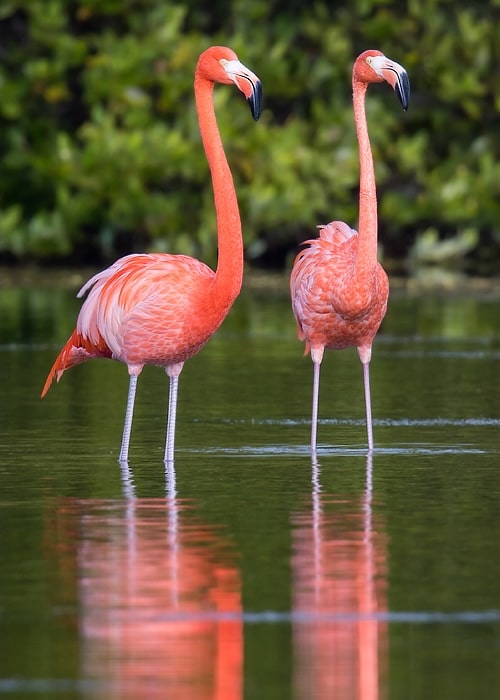
The Turks and Caicos Islands are a British Overseas Territory consisting of the larger Caicos Islands and smaller Turks Islands, two groups of tropical islands in the Lucayan Archipelago of the Atlantic Ocean and northern West Indies. They are known primarily for tourism and as an offshore financial centre. The resident population is around 47,000 people. The islands are southeast of Mayaguana in the Bahamas island chain and north of the island of Hispaniola (Haiti and the Dominican Republic). Cockburn Town, the capital, is situated on Grand Turk about 1,042 kilometres (647 miles) east-southeast of Miami. They have a total land area of 430 km2 (170 square miles).
The Caicos Islands are separated by the Caicos Passage from the closest Bahamian islands, Mayaguana and Great Inagua. The nearest foreign landmass from the Turks and Caicos Islands is the Bahamian island of Little Inagua, about 48 kilometres from West Caicos. The eight main islands and more than 22 aller islands have a total land area of 616 km2 (238 square miles), consisting primarily of low, flat limestone with extensive marshes and mangrove swamps and 332 square kilometres (128 square miles) of beach front. The tallest peaks in the islands are Blue Hills on Providenciales and Flamingo Hill on East Caicos, both at a modest 48 m.]
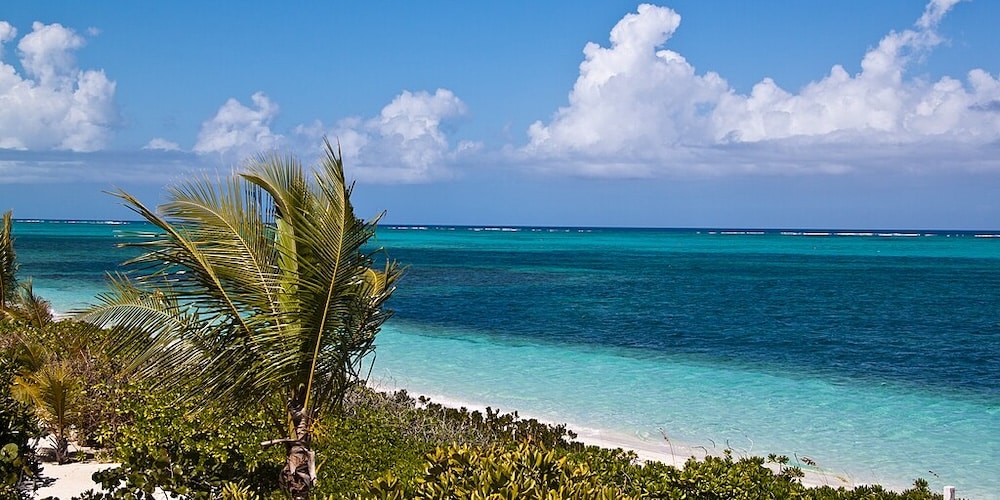
Turtle Cove, Providenciales – ©Tim Sackton via Wikimedia Commons
The weather is usually sunny (it is generally regarded that the islands receive 350 days of sun each year) and relatively dry, but suffers frequent hurricanes. The islands have limited natural fresh water resources; private cisterns collect rainwater for drinking. The primary natural resources are spiny lobster, conch, and other shellfish. Turks and Caicos contains three terrestrial eco-regions: Bahamian dry forests, Bahamian pineyards, and Bahamian-Antillean mangroves. The two distinct island groups are separated by the Turks Island Passage.
The Turks Islands are separated from the Caicos Islands by Turks Island Passage, which is more than 7,200 feet deep. The islands form a chain that stretches north–south and it and the much smaller Salt Cay are the only inhabited islands of the group. Together with nearby islands, all on Turks Bank, those two main islands form the two administrative districts of the territory (out of six in total) that fall within the Turks Islands. Turks Bank, which is smaller than Caicos Bank, has a total area of about 324 km2. Some of the main uninhabited islands are: Big Sands Cay, Cotton Cay and Endymion Rock. The Mouchoir Bank is 25 kilometres east of the Turks Islands and is separated from them by Mouchoir Passage. Although it has no emergent cays or islets, some parts are very shallow and the water breaks on them. Mouchoir Bank is part of the Turks and Caicos Islands and falls within its Exclusive Economic Zone. It measures 958 km2 in area. Two banks further east, Silver Bank and Navidad Bank, are geographically a continuation, but belong politically to the Dominican Republic.
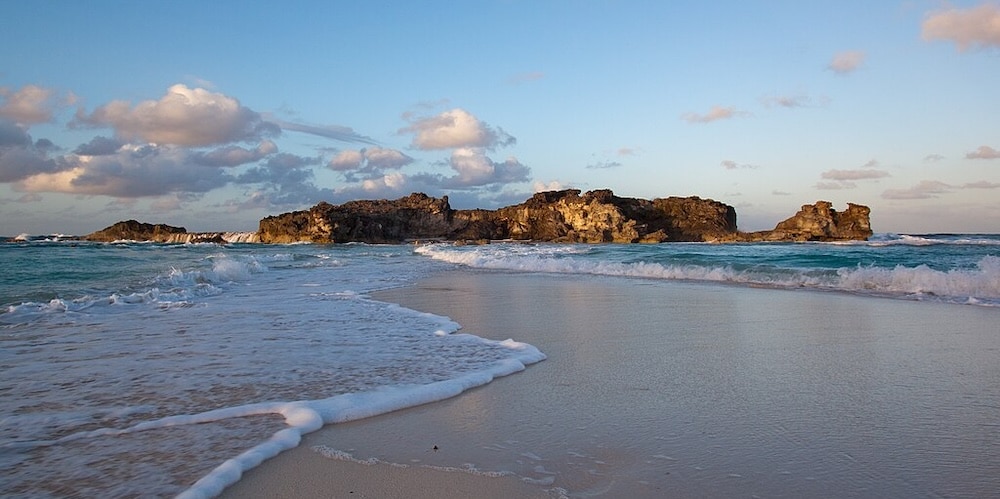
Dragon Cay – ©Tim Sackton via Wikimedia Commons
The largest island in the Caicos archipelago is the sparsely-inhabited Middle Caicos, which measures 144 km2 in area, but has a population of less than 200 people. The most populated island is Providenciales, with c. 24,000 inhabitants and an area of 122 km2. North Caicos (116 km2 in area) has c.1,300 inhabitants. South Caicos 21 km2 in area) has c. 1,150 inhabitants, and Parrot Cay (just 6 km2 in area) has about 130 inhabitants. East Caicos is uninhabited, while the only permanent inhabitants of West Caicos are resort staff. The Caicos Islands also has many uninhabited and small island including Ambergris Cay, Frencg Cay, Pine Cay and West Sand Spit among others.
The Turks and Caicos Islands feature a tropical savannah climate, with relatively consistent temperatures throughout the course of the year. Summertime temperatures rarely exceed 33 °C and winter night-time temperatures rarely fall below 18 °C. Water temperature in the summer is 28-29 °C and in winter about 74 to 23-26 °C. A constant trade wind keeps the climate at a very comfortable level.
Birding the Turks & Caicos
The Turks and Caicos Islands are a biodiversity hotspot. The islands have many endemic species and others of international importance, due to the conditions created by the oldest established salt-pan development in the Caribbean. The variety of species includes a number of endemic species of lizards, snakes, insects and plants, and marine organisms; in addition to being an important breeding area for seabirds. The UK and Turks and Caicos Islands Governments have joint responsibility for the conservation and preservation to meet obligations under international environmental conventions. Due to this significance, the islands are on the United Kingdom’s tentative list for future UNESCO World Heritage Sites.
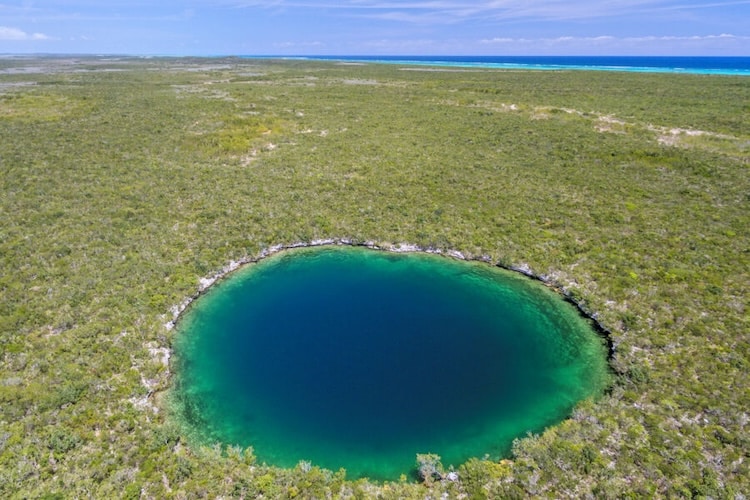
North Caicos – ©Dirk2112 via Wikimedia Commons
‘Beautiful by Nature’ is the National slogan of the Turks and Caicos Islands which is rumoured were discovered by Christopher Columbus in 1492 and now some 500 years later is being rediscovered as one of the fastest growing travel destinations in the Caribbean. The British Oversea Territory is famous for her secluded beaches, crystal clear turquoise blue waters, unspoilt reefs and dramatic walls and has some of the best diving and snorkelling in the world.
These days however, beside their bronzing creams, visitors should pack a good pair of binoculars! The Turks and Caicos has tweaked the interest of serious birders especially since 1992 when the government set aside 33 protected areas of National Parks, Nature Reserves and Sanctuaries. Now over 200 bird species can be found at varying times of the year throughout the islands mainly due to the fact that the Bahamas chain is an important route for migratory birds between North and South America. Of these at least 52 are known to breed locally.
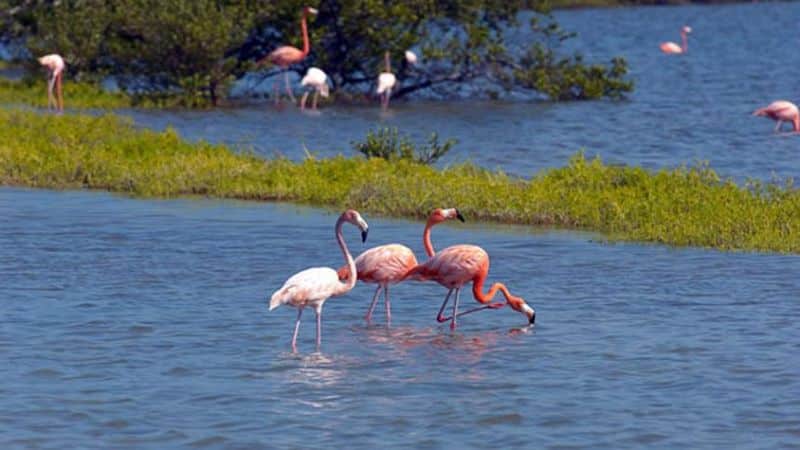
East Caicos – Public Domain via Wikimedia Commons
In 1990 the Southern coasts of North, Middle and East Caicos were designated a RAMSAR site to ensure the protection of endangered wetlands. Here in the lagoons, salt ponds and mangrove swamps can be found over 60 waterfowl species including the rare West Indian Whistling duck and Greater Flamingo.
-
Number of bird species: 236
(As at February 2025)National Bird: Brown Pelican Pelecanus occidentalis
-
Avibase
PDF ChecklistThis checklist includes all bird species found in Turks and Caicos Islands , based on the best information available at this time. It is based on a wide variety of sources that I collated over many years. I am pleased to offer these checklists as a service to birdwatchers. If you find any error, please do not hesitate to report them. -
E-Bird
PDF ChecklistThis checklist is generated with data from eBird (ebird.org), a global database of bird sightings from birders like you. If you enjoy this checklist, please consider contributing your sightings to eBird. It is 100% free to take part, and your observations will help support birders, researchers, and conservationists worldwide. -
Wikipedia
Annotated ListThis is a list of the bird species recorded in the Turks and Caicos Islands. The avifauna of the Turks and Caicos Islands included a total of 235 species according to Bird Checklists of the World as of October 2024.
-
A Birder's Guide to the Bahama Islands (Including Turks and Caicos)
| By Anthony W White | ABA | 1998 | Spiralbound | 302 pages, Col and b/w photos, illus, maps | Out of Print | ISBN: 9781878788160 Buy this book from NHBS.com -
Birding in Paradise – Grand Turk
| Turks & Caicos Islands: A Guide to Bird-Watching and Heritage Sites | By Mike Pienkowski, Ann Pienkowski, Bryan Naqqi Manco & Kathleen McNary | UK Overseas Territories Conservation Forum | 2015 | Paperback | 52 pages, colour photos, colour maps | ISBN: #227052 Buy this book from NHBS.com -
Birding in Paradise – Middle & North Caicos
| Turks & Caicos Islands: A Guide to Bird-Watching and Heritage Sites | By Mike Pienkowski, Ann Pienkowski, Bryan Naqqi Manco & Kathleen McNary | UK Overseas Territories Conservation Forum | 2015 | Paperback | 52 pages, colour photos, colour maps | ISBN: #227053 Buy this book from NHBS.com -
Birding in Paradise – Providenciales
| Turks & Caicos Islands: A Guide to Bird-Watching and Heritage Sites | By Mike Pienkowski, Ann Pienkowski, Bryan Naqqi Manco & Kathleen McNary | UK Overseas Territories Conservation Forum | 2015 | Paperback | 52 pages, colour photos, colour maps | ISBN: #227051 Buy this book from NHBS.com -
Birding in Paradise – Salt Cay
| Turks & Caicos Islands: A Guide to Bird-Watching and Heritage Sites | By Mike Pienkowski, Ann Pienkowski, Bryan Naqqi Manco & Kathleen McNary | UK Overseas Territories Conservation Forum | 2015 | Paperback | 52 pages, colour photos, colour maps | ISBN: #227055 Buy this book from NHBS.com -
Birding in Paradise – South Caicos
| Turks & Caicos Islands: A Guide to Bird-Watching and Heritage Sites | By Mike Pienkowski, Ann Pienkowski, Bryan Naqqi Manco & Kathleen McNary | UK Overseas Territories Conservation Forum | 2015 | Paperback | 52 pages, colour photos, colour maps | ISBN: #227054 Buy this book from NHBS.com -
Birds of the Bahamas and the Turks & Caicos Islands
| By Bruce Hallett | Macmillan Caribbean | 2006 | Paperback | 245 pages, colour photos, b/w illustrations, 1 colour & 1 b/w map | Out of Print | ISBN: 9780333937440 Buy this book from NHBS.com -
Birds of the West Indies
| By Guy M Kirwan, Anthony Levesque, Mark W Oberle & Christopher J Sharpe | Lynx Edicions | 2019 | 400 pages, 1600+ colour illustrations, 650+ colour distribution maps | ISBN: 9788416728176 Buy this book from NHBS.com -
The Birds of the Turks & Caicos Islands
| By Richard Ground | Turks and Caicos National Trust | 2001 | Hardback | 94 pages, colour photos | ISBN: 9789769507906 Buy this book from NHBS.com

Birds of the West Indies
AndroidThis bilingual, mobile field guide for the West Indies includes all 415 bird species of Puerto Rico and the northeastern Lesser Antilles: Virgin Islands, Anguilla, Saint Martin (Sint Maarten), Antigua and Barbuda, Montserrat, Sint Eustatius, Saint Kitts and Nevis, Saint Barthélemy (St. Barts), and Saba.
Birds of the West Indies
Apple iOS |Explore the vibrant Caribbean islands with Birds of the West Indies – your pocket guide to Caribbean birdwatching!Organisations-
Turks & Caicos National Trust
Facebook PageTurks & Caicos National Trust - P.O. Box 540 ~ Providenciales ~ Turks & Caicos Islands ~ BWI Phone:649 941 5710 ~ Fax:649 941 4258 ~ Email: tc.nattrust@tciway.tc Mission statement: To establish itself as a self-sustaining organization through the preservation, development and promotion of the heritage of the Turks and Caicos Islands; to create awareness by and opportunities for the people through education and participation; and to ensure that present and future generations take pride in and enjoy the benefits of their heritage. Also see Facebook Page -
UK Overseas Territories Conservation Forum
WebsiteThe UK Overseas Territories Conservation Forum [UKOTCF] exists to promote the coordinated conservation of the diverse and increasingly threatened plant and animal species and natural habitats of the UK Territories Overseas
Reserves-
BS Long Cay
InformationSatellite ViewThis long and narrow uninhabited 45 acre cay is located south of Grand Turk. The island is an important nesting site for seabirds, and has a environment of low coastal vegetation and limestone coastlines. -
NP North West Point Marine
InformationSatellite ViewLocated on the northwestern part of the island of Providenciales, 5.2 miles northwest of Blue HillsNorthwest Point Marine National Park includes nearby reefs and several saline lakes that attract breeding and migrant birds -
NR Lake Catherine Nature Reserve
InformationSatellite ViewLake Catherine is a very shallow 430-acre (174-hectare) saline wetland nature reserve. This site is a highly-important nesting region for wading birds, as well as a prime habitat for flamingos. -
NR Pigeon Pond and Frenchman’s Creek
InformationSatellite ViewThe Pigeon Pond and Frenchman’s Creek Nature Reserve is a time capsule of TCI’s natural history, and features hundreds of acres of pristine tropical woodlands represented by hardwoods, orchids, perching birds and reptiles some of which are found nowhere else on earth. -
National Parks & Nature Reswerves
InformationSatellite ViewThere are four categories of protection: national parks, nature reserves, sanctuaries, and areas of historical interest. Every major island in the country has at least two protected sites.
Sightings, News & Forums-
eBird
SightingseBirding This Month
Guides & Tour Operators-
Talbots Adventures
Local Tour OperatorDiscovering the Reddish Egret: A Birding Adventure in Turks and Caicos
Trip Reports-
2011 [03 March] - Peter Osborn
PDF Report...The surrounding area, with its numerous undeveloped plots towardsRichmond Hills, held a variety of warblers including migrant Northern Parula and resident YellowWarbler, species that would become well-known over coming days such as Thick-billed Vireo(heard singing all over the islands), Bahama Woodstar, Common Ground Dove and NorthernMockingbird, plus a good sighting of a Mangrove Cuckoo. One of the memorable points of the visitwas the number of birds that gave stunning views... -
2020 [01 January] - Derek Matthews
ReportTurks & Caicos was really intended as a relaxing couple of days on our way to Dominican Republic and Puerto Rico to bird. Having said that there were 5 lifers there for us so we didn’t get a guide and didn’t waste any time. We used ebird to find the most recent sightings.
Places to Stay-
Crabtree Apartments - Grand Turk
AccommodationCrabtree Apartments are 3 quaint Bungalow like, 2 bedroom, 1 bath, vacation rental units directly on the beach. Each unit has 2 air-conditioned bedrooms one with an oceanview and queen bed and one with 2 twins that can be converted into a king with a view of the salinas and the wildlife they attract. -
Dragon Cay Resort (Formerly Blue Horizon Resort)
AccommodationDragon Cay Resort (Formerly Blue Horizon Resort) is a unique tropical destination tucked behind 2,200 feet of naturally preserved beachfront on Middle Caicos, the largest but least developed of the eight inhabited islands in The Turks & Caicos Islands. When you stay at one of the private Cottages or Villas at Dragon Cay Resort, you will be immersed in a privacy and tranquillity not common in today’s Caribbean Resort Landscapes... -
Villa del Mar
AccommodationFor birders, the Turks and Caicos Islands entices visitors with a chance to spot the Bahama Woodstar Hummingbird and the Reddish Egret among many other species and sub species. The rocky outcropping, protected wetlands, and scrubby brush are home to breeding birds, birds of prey and other unique Caribbean species. And while bird watching in the Turks and Caicos Islands may not be the reason you plan your Caribbean vacation, seeing these local species is a wonderful and memorable experience.
Other Links-
Bird Watching
InformationThe salt ponds and inland marshes serve as excellent feeding grounds for resident and migratory birds. Search for Great Blue Herons, Flamingos, Osprey and Pelicans alongside Egrets, Terns, Frigates, Boobies and other water birds. -
Caribbean Birding Trail - Turks & Caicos
Information...Further shallow banks (Mouchoir, Silver and Navidad) to the south-east, some within TCI territory, are important for whales and probably for feeding seabirds. The Bahamas lie on separate banks to the northwest, and share some aspects of the geography...
Fatbirder - linking birders worldwide...
Skip to content
